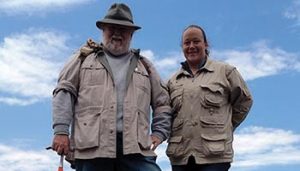By Joseph “PaleoJoe” Kchodl
CYPHASPIS carrolli is a rare and spectacular trilobite. Found in the Haragan Formation in Coal County, Oklahoma, it is a recent addition to the body of scientific knowledge about trilobites.
Trilobite paleontologist Robert Carroll discovered CYPHASPIS carrolli in the quarries in which he works in Oklahoma. He is a professional preparer, and that is important.
This diminutive trilobite has a very inflated Cephalon and glabella. The eyes are set high on the Cephalon on little stalks. It has large (compared to its size) genal spines and especially a large axial spine rising up from the middle of the thorax.
The new species was named in honor of Robert Carroll and all the work he has done.
DID YOU KNOW: Trilobites, an extinct form of arthropod related to insects, crabs, crayfish, and horseshoe crabs, are among the most prevalent invertebrates with hard body parts to appear during the Cambrian Period. These creatures are called trilobite due to the three distinct “lobes” running vertically through the body section.

About the columnist: Joseph “PaleoJoe” Kchodl is a paleontologist, educator, veteran, author, fossil dig organizer/guide, business owner, husband, father, and grandfather, and fossil fanatic. For decades, he’s spent hours in classrooms around the Midwestern United States and beyond, speaking to school children about fossils and fossil hunting. Visit his site to purchase fossils, contact PaleoJoe, visit www.paleojoe.com.
Plus, learn more about PaleoJoe and his daughter PaleoJen and their paleontology exploration partnership in an the article “Fueling a Passion for Paleontology“.

